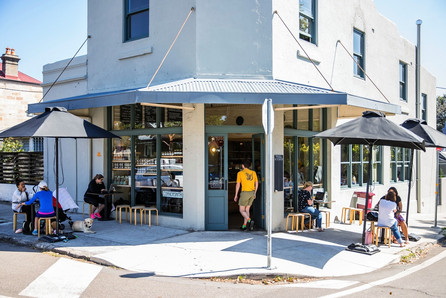Use it all the Cornersmith way
- rosemary
- Jul 13, 2021
- 5 min read
Updated: Jul 21, 2021
"buy less, buy whole, use it all." Alex Elliott-Howery and Jaimee Edwards"

At last I'm getting to my birthday present cookbook which is shown here. To tell the truth I have mixed feelings about this book. In lots of ways it epitomises my resistance to the 'health and wellness, green' gurus of the cooking world but it is also full of wonderful ideas about what to do with every bit of your food.
So a bit of background about the authors and the history of Cornersmith - the café in Sydney which is the inspiration for this book. They are two old friends who live in Sydney.
Alex Elliott-Howery and her husband James Grant opened their corner café Cornersmith in Sydney's Marrickville in 2012 because:
"They wanted to eat at a café that shared their philosophy on making thoughtful decisions concerning food, food waste and the environment. A café that – coupled with 'really good food and really good coffee, – had great vibes and a real sense of community'. When they couldn’t find one, they opened one." Habitus Living

From day one it was full - who knows why? Of course the owners say they were different and nobody else provided such food, but surely that can't be true?
Be that as it may, besides the café what really distinguished their business was the move into making preserves of all kinds. Jaimee Edwards, the other author of this particular book and an old friend of Alex's is the fermenting whiz I believe. They opened a pickling space, nearby - now there is a much larger and newer one - and sold their produce online and in the café. The really, really interesting thing about this though is that the preserving thing started through Alex asking all her neighbours - lots of Greeks apparently - if she could have their surplus fruit and vegetables. They were mostly glad to give them to her, and she would reciprocate with a jar of the finished product and perhaps a cup of coffee.
"The Cornersmith became a swap-meet, where locals might trade a box of lemons for a jar of lemon preserve, pickles or even coffee. ..."
Nowadays she doesn't even need to go and find the fruit and vegetables. People bring the stuff to them. The trading system continues. But I do ask myself if this is a fair trade? A 350gram jar of jam or pickles from Cornersmith will set you back $14.00 which, whilst not exorbitant is more than twice as much as you would pay for the most expensive supermarket jam. I'm sure not all their raw materials are free, and it is admirable that such materials are being put to such good use, but is a jar of jam or pickles adequate recompense? Is this exploitation? Alex Elliott-Howery defends the practice with:
"People see we are say, getting a free box of lemons, but you could go to the markets and it's not expensive, so it's less about saving money on produce, it's more the flow-on effects from creating ties with people."
True, but I do feel a bit uneasy about it. They also run cooking and preserving classes - not cheap, but then none are. Or you could buy their books and learn from them, or watch any number of videos on the net from various other experts - the River Cottage people for example - for free.
The Marrickville café closed in 2019 but they retained their second café in Annandale. So far so very much like so many other cafés you would think. It absolutely must be the pickles, and things that make them so renowned.
And they now have three cookbooks out there on the shelves, an online store, cooking and preserving classes, both online and in person, etc. So well done. Canny business people anyway, and I gather that the café is vegetarian although they don't make a big thing about it.
To the book. It is structured around ingredients in the form of 8 shopping baskets of complementary and seasonal ingredients, that always include one form of protein, together with the seasonal fruit and vegetables. Like this first one:

Following on from this you get a rundown of the recipes that follow, and then they launch into each separate ingredient with a little lecture on buying organic, free-range, etc. - 'we never buy meat from the major supermarkets' is one example of the tone. However, they then give out very useful information on nutritional value, what each ingredient goes with, how to buy, how to store, what to do with every bit. For example for those eggs in basket one you get two delicious 'foundation' recipes - the vegetable slice and the baked eggs shown here - i.e. basic recipes with a number of suggested variations. So more of a method than an actual recipe, although it is.
But then you also get a whole lot of fun and unusual stuff - like what to do with leftover whites - not a pavlova in sight - instead there are whiskey sours, spicy nuts and seeds, toasted muesli and coconut macaroons. And the yolks - cured egg yolks, strawberry curd, and mayonnaise - or just freeze them. And it's these smaller things that are really the stars of the book I think. That and the tips on how to use every little bit of everything, unless, like rhubarb leaves, they are poisonous.
Every now and then I got annoyed by little things like 'use your kimchi juice' for something, which sort of took it for granted that you would have kimchi juice. And the occasional preachy statement about never buying things like sausages in a supermarket - "they have so many additives'. Now as it happens I do mostly buy my sausages from butchers, but this means that I have no idea what is in them. It's sort of a trial and error thing in deciding which ones are best. I actually checked out some 'gourmet' sausages from one of the supermarkets, and the list of ingredients seemed to consist of actual foodstuffs apart from preservative. Picky I know but these are the silly things that get to me.
Because overall this is a pretty wonderful book with lots of brilliant ideas for ways of using things past their best, or every little bit of what is before you. Some of the recipes looked great too. I'm going to try these variations on the gozleme theme some time soon I think. Probably not very original but beautifully photographed - as is the whole book - and infinitely variable. Perhaps we could make them for our next kids' cooking class.









Comentários